Science-Fiction films - 2018
| Rampage | Maze Runner: The Death Cure | The Meg |
| Jurassic World: Fallen Kingdom | Upgrade | Solo: A Star Wars Story |
| Ready Player One | Pacific Rim Uprising | Annihilation |
| The Cloverfield Paradox |
____________________
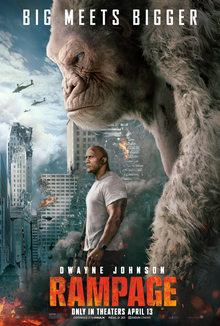 |
While it's far from cutting-edge science-fiction, Rampage is a genuinely fun time at the movies due to its decent special effects and likeable performances from Dwayne Johnson, Naomie Harris, and Jeffrey Dean Morgan. Weta Digital is credited with providing the effects of "George," the giant albino gorilla, using their experience from King Kong (2005) and the recent Planet of the Apes franchise (2011-2017).
- Swift
____________________
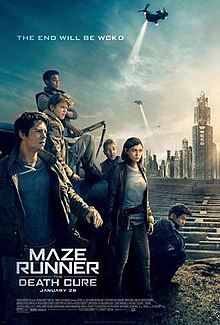 |
While the Maze Runner films are essentially action movies that are simply set in yet another dystopian sci-fi universe, this one comes to a reasonably satisfying conclusion. There are many gripping action scenes and the young actors are quite good, particularly Dylan O'Brien, Thomas Brodie-Sangster, and Rosa Salazar.
- Swift
____________________
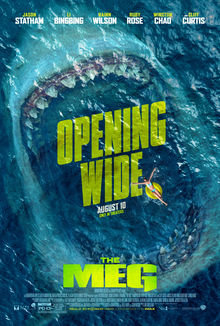 |
In a year of film largely dominated by superheroes, aliens, and over-the-top horror, I can honestly say that The Meg sounded like a breath of fresh air - or salt water, if you prefer.
"Meg" is short for megalodon ("big tooth"), a creature that actually existed between 23 to 2.6 million years ago on our little planet. Megalodon is thought to be the largest predator known to have existed, growing to lengths of 60 feet, weighing up to 65 tons, and possessing a bite force of 40,000 pounds. Thought to have fed largely on whales, dolphins, seals, and other sharks, they were the apex predators of the world's oceans, with their fossilized remains found all over the world. It is thought that they became extinct due to falling water temperatures and the movement of their prey to cooler environments than they could adapt to.
In our story, a deep-sea research team investigating the Mariana Trench encounters a large sea creature which cripples their ship. Rescue diver, Jonas Taylor (Jason Statham) is called in to mount a rescue and he and the others realize that the gigantic predator is a very not extinct megalodon. Though they are able to make it back to the surface, they later discover that the huge shark has followed them up from the trench. It soon begins wreaking havoc in the area and they attempt to stop it.
A lot of fans and critics have criticized The Meg, for either being too dumb or not dumb enough. Held to the standards of Jaws or Sharknado, one can probably see what they are saying, but I don't know how reasonable the comparisons are. It is as if a shark movie has to be an intensely suspenseful drama or pure goofy schlock. I don't believe that these are the only kinds of shark movie that should be allowed to exist. This film really reminds me more of an underwater Jurassic World or an updated giant monster movie along the lines of Japan's Toho films - pitting a gigantic, prehistoric force of nature against likeable human leads. I actually enjoyed this film, even if it didn't fit either of the paradigms that others may have wanted to force it into. While it probably won't earn as much at the box office, I thought it was a step up from this year's Jurassic World: Fallen Kingdom.
The Meg also has an appealing cast. Statham is clearly the star of the film, but in this American-Chinese co-production, Chinese actress Li Bingbing is an attractive co-star to balance him. Rainn Wilson, Ruby Rose, Cliff Curtis, and Shuya Sophia Cai are also good in supporting roles.
The Meg isn't the greatest movie ever made, nor is it even the greatest shark movie, but it's a fun enough time at the theater for me to recommend it.
- Swift
____________________
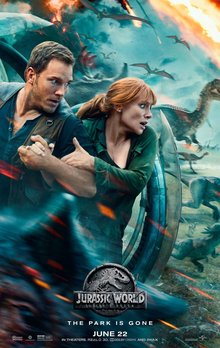 |
This sequel to 2015's Jurassic World is mostly more of the same. It's always nice to see dinosaurs walking around, but like its predecessor, it's mostly suited to 8 to 12-year-olds.
____________________
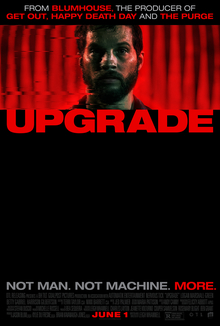 |
Upgrade is the second film both written and directed by Leigh Whannel. Whannel's career has taken him from acting in over twenty films, writing several of the original Saw and Insidious films, and eventually he moved to the director's chair, his first writer/director effort having been Insidious: Chapter 3 (2015). His career is reminiscent of that of other writer/director talents working today - James Wan (Whannel's friend and colleague) and Alex Garland - who have been the creative drive for lower-budget productions with more intelligent concepts. While Insidious: Chapter 3 was a modest success, somewhat surprising for a third film in a horror series, Upgrade shows us that Whannel has a gift for action, science-fiction, and horror in a blend which keeps its viewers fully engaged in what may turn out to be an unexpected hit.
The story: In a not-too-distant future, Grey (Logan Marshall-Green) is something of a latter-day luddite, making his living from home, restoring vintage automobiles and listening to vinyl records. Ironically, he is happily married to Asha (Melanie Vallejo), who works for a high-technology company and prefers her self-driving car. After driving with Grey as he delivers a restored car to a wealthy tech-client, Eron Keen (Harrison Gilbertson), Asha and Grey's self-driving vehicle goes out of control and crashes. They are confronted by four men who kill Asha and injure Grey. Grey becomes a paraplegic as a result and he is forced to come to grips with his loss of his mobility, the loss of his wife, and the seeming inability of police detective Cortez (Betty Gabriel) to make any headway on finding the men responsible. Eron comes to Grey with an offer to implant an experimental device on Grey's spine to cure his paralysis. Grey eventually accepts, and while the implant - STEM - returns the use of his arms and legs it also provides him with other abilities that allow him to investigate his wife's murder.
Good points: The revenge plot is a familiar one, but it still works and probably always will. Marshall-Green does a good job of conveying Grey's feelings after his devastating loss. He is also quite good at physically portraying both a crippled man and a cybernetically-enhanced killing machine. There are some instances that are both horrifying but nearly comical as Grey allows STEM to take over in beating a bad guy to a pulp while Grey's face and voice reflect the horror of what he sees STEM doing. In terms of the plot, the adversaries that Grey has to contend with are enough of a challenge to make the pursuit interesting. And as he follows the chain of bad guys to the eventual big bad, there are some twists and turns to the story that I did not see coming (always a welcome suprise).
Quibbles: For a relatively small sci-fi story, as opposed to some epic tale, this film does what it sets out to do, so I don't have many quibbles. One could nit-pick the plot for some leaps and gaps in logic, but for a film that focuses mostly on the action and the scares, I don't think it's worth dwelling on these things. One small distraction to me was the casting of Betty Gabriel as the detective. First, I have seen this actress in so many different films of late (HBO's Westworld, The Purge: Election Year (2016), Get Out (2017)) that it was difficult to completely separate her from those roles, especially when they seemed to give her more dimension than this one. Second, her detective Cortez character fell into the annoying trope of the cop who, while utterly incompetent in finding the killers, is remarkably astute in coming down on our protagonist doing what she failed to do.
Overall, this film was a pleasant surprise - emotionally engaging, suspenseful, and with its share of excitement. I recommend it to viewers on both the big and small screens. I also look forward to writer/director Whannel's projects to come.
- JC
____________________
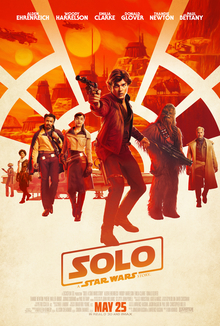 |
Once upon a time, not so long ago, in a boardroom in the Disney galaxy:
"The Force Awakens is one of the biggest hits of all time! I told you buying the Lucas stuff would pay off for us!"
"You were so right, sir."
"But they were suckers back in the old days. They should have milked this cash cow for all it was worth! You think those Marvel movies made us money? That's gonna fizzle out one of these days. Star Wars has been around a lot longer than the stupid comics."
"Well, as a point of fact, sir . . . "
"No waiting three flipping years for the next one, but why should we settle for just another measly trilogy? Marvel has its Avengers line with all the characters together, but think how much they've made with the single-character movies! We can do that with Star Wars too! You know how much everybody loved that prequel trilogy that showed us the early days of Darth Vader, Obi-Wan, and Yoda. The fans will eat up more prequel trilogies with Han, Chewbacca, Boba Fett . . . you know, anyone with an outfit. We need to remember the lego kit sales."
"But sir, the prequel trilogy wasn't that well received."
"But it made money didn't it? That's how you know if things are any good. Oh, and by the way, after this first one with the new kid characters and after getting rid of the first of the old guys, we really need to fix the tone of these movies."
"Fix the tone, sir?"
"The new audiences like their movies all dark and gritty now. They like imperfect, damaged heroes who screw up or act like criminals. We don't want to mess up our new characters too soon though. But we can screw up the old ones as much as we want. We're gonna pick 'em off with every new movie anyway."
"But I thought the optimistic tone of The Force Awakens was popular."
"Maybe at first, but remember they said it copied the original Star Wars too much? We gotta go dark like that big superhero flick from a couple years ago."
"A Marvel one?"
"I don't remember. They all seem about the same to me. The big superhero one with the two guys in capes fighting each other and then they team up with the hot chick to fight a giant gray frog monster. All shot at night, of course."
"Oh, sir . . . "
"In fact, let's have a prequel where everybody dies. We'll have to come up with different characters that are knockoffs of our main ones, but who cares? As long as we stick "Star Wars" on the title and maybe sneak in a Darth Vader cameo where he goes nuts with a light sabre, who won't want to see it? And think of all the legos . . ."
"I'm sorry to disagree sir, but darkening the tone and tarnishing classic heroes doesn't sem like either the Star Wars way or the Disney way."
"What do YOU know kid? You probably grew up on this silly stuff. I've been in the business forty years! Now get me a list of edgy, inexperienced directors so we can get this show on the road!"
Or at least, it might have been something like that. Or perhaps it just seems that way.
Solo: A Star Wars Story gives us another prequel to Star Wars: A New Hope (1977), which tells us the backstory of Han Solo (here played by Alden Ehrenreich) covering his life from apparently his late teens to early twenties. It depicts his early beginnings as a street orphan thief who flees that life to join the Imperial Space Navy to learn to pilot and fight. After another few years he leaves the Empire to join a gang of thieves. We see how Han came to be the character we know from the Star Wars original trilogy, how he met familiar characters Chewbacca (Joonas Suotamo) and Lando Calrissian (Donald Glover), and how he came to acquire the Millenium Falcon. We are also introduced to important characters from his past - the girl he grew up with and his first love, Qi'ra (Emilia Clarke), and Tobias Beckett (Woody Harrelson), the leader of the group of thieves Han falls in with who becomes a mentor to him. We follow Han in his early years of carrying out heists, dealing with shady characters and rebels to the Empire, and learning how to make his way in that world.
So, how was it?
Many reviewers and fans have made the same comment - Did we really need a Han Solo prequel? To what extent do we need any movie? The question really is, was there a demand for one? Given the lack of new revelations about Han's past other than general information and getting to see things that we already knew about from past films, this movie doesn't really add that much to the character. The addition of Qi'ra and Beckett help flesh out Han's past and perhaps explain his tendencies towards cynicism. Those familiar with the character of Han Solo from the prior Star Wars films could easily infer the existence of characters like this in his past. This film just gives them faces and names.
The actors are fine in their respective roles, but since the characters are so two-dimensional they don't really have that much to work with. I was interested in the casting of Thandie Newton in this film from seeing her work elsewhere, but she is largely wasted here. Since Solo is more of a space-western than a space-opera, at times the overblown special effects and the heavy score by John Powell (borrowing heavily from John Williams) seem a bit much. But given its place within the Star Wars anthology series, all the trappings of the series are probably just part of the package.
Overall, Solo is pretty miss-able. Critical and fan response has been lukewarm. Disappointing box office is probably attributable to the lack of demand for a Han Solo prequel and the bad taste that The Last Jedi (2017) left in many fans' palates. Unless you are a die-hard Star Wars fan that has to see everything as soon as it comes out, this is about as sadly forgettable as Disney's earlier (and also very expensive) sci-fi effort, John Carter. It would be reasonably entertaining viewing some evening in a year or two on the small screen.
- JC
____________________
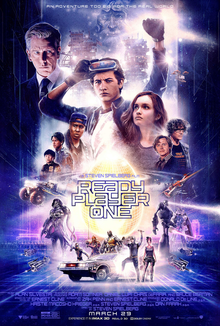 |
Ready Player One, essentially Steven Spielberg's love letter to video pop culture, presents us with a world that somewhat darkly reflects our own. It shows us a bleak, day-to-day physical world which borders on a rich fantasy world of highly-developed video gaming. This dichotomy is largely played lightly, with both elements of fantasy-like wonder ala Willy Wonka, but also some elements of "grunge" dystopian sci-fi. Iconic director Spielberg (Jaws (1975), Raiders of the Lost Ark (1981), E.T. the Extra-Terrestrial (1982), Jurassic Park (1993), to name just a few) produced and directed the film, from a screenplay co-written by Zak Penn (X-Men: The Last Stand (2006), The Incredible Hulk (2008)) and Ernest Cline, the writer of the novel Ready Player One (2011) that the film is based on.
The Story: Set in 2045, the real world is an ugly place - overcrowded, with the bulk of people living in poverty. The only option for escape from dingy reality for most is the current pablum for the masses: an online virtual reality environment called the "Oasis" where players can competitvely game or simply enjoy all the benefits of a fantasy reality where they can do or be whatever they wish. Wade Watts (Tye Sheridan), an 18-year-old gamer living with his aunt in the slums of Columbus, Ohio, is one of many players seeking to find an "Easter Egg" hidden in the Oasis. The creator of the Oasis, James Halliday (Mark Rylance) who passed away six years prior, left clues in the form of three virtual keys that would lead to the Egg. Acquisition of the Egg gives the finder a huge payoff in wealth in the real world as well as control of the Oasis virtual environment. This has led to a number of players seeking it, but also video game corporation IOI, headed by CEO Nolan Sorrento (Ben Mendelsohn), who will stop at nothing in the virtual or real world to obtain it.
Wade, a student of Halliday's life, is the first to acquire one of the keys to the Egg. With the assistance of virtual friends he has never met in reality, Wade "wades" through layers of puzzles embedded in pop culture imagery to unravel Halliday's mystery. Along the way, he meets another gamer, Artemis (Olivia Cooke), who leads him to realize that life is more than just a game and that the stakes involved reach into the real world which Wade has sought to escape.
Good points: If one is a fan of the overly-fast-paced bedlam of video gaming, many of the action pieces will be for you. Especially, the cityscape race animation from the early part of the film will be practically dizzying. Sheridan and Cooke are very likeable leads and the other members of Wade's band of gamers (the "High Five" due to their board rankings) are fun characters in both their virtual world and real world existences. Simon Pegg is also a welcome presence in the film, as Ogden Morrow, Halliday's original partner and co-creator of the Oasis.
Quibbles: I have to admit that I'm not a gamer, so some of this is lost on me. (I burned out on video games in the '80s.) And I am painfully aware that it's possible to lose oneself too much in fantasy. (Look at the content of this website.) So, several times I found myself annoyed by the pop-culture pretentiousness of people who have spent too much of their lives in fantasy, striving for dominance among others with knowledge of useless information, and neglecting the real world around them. (That being said, I totally geeked out when I realized that the spell cast in the film was the Charm of Making from Excalibur (1981) which I took the trouble to memorize way back then and still remember.)
While the depictions of activity in the virtual world were good, I felt we spent too much time there. It was time spent in reality that developed the characters as human beings and gave dimension to them in the virtual world as well. I would have liked to have known more about that society to give better understanding of why the Oasis was so attractive and why control of it was so important. The real world of this film felt somewhat reminiscent of that in The Running Man (1987), though without an overtly totalitarian government. But in that film, as well as in this one, futuristic gaming/entertainment had attracted and distracted the public consciousness from focusing on reality, allowing it to continue to decay.
The characterization of the villain, Nolan Sorrento, seemed a bit uneven. He slid back and forth between being imposing and being a buffoon. (His password on a slip of paper, really?) It was hard to imagine how he could have risen to the position he was in without having a higher level of sophistication. Also, I thought Rylance may have over-played his portrayl of Halliday. I know he was supposed to be a socially-inept creative genius, but his deeply Asperger's version of Halliday made him seem too dull to have created something as wildly creative as the Oasis.
From the perspective of the marketability of this film, I wonder if it may have lost its window of opportunity. While it may have seemed relevant at the time of the novel's writing nearly 10 years ago, the World of Warcraft cultural phenomenon hit its peak in 2010. I also wonder if it made sense to set the story so many years into the future. First, neither the socio-economic changes nor the technological changes really seem to have required nearly 30 years. Second, for a story set that far in the future to only have pop culture references that cover audiences now, requires some explanation. Were no books written or films produced after the 2010s?
Ready Player One should appeal to gamers and pop culture fans, but ironically, the parts of the story set in reality are the ones that lack realism and if the film has a message worth passing on, it's that reality is the place one should concentrate on living one's life.
- JC
____________________
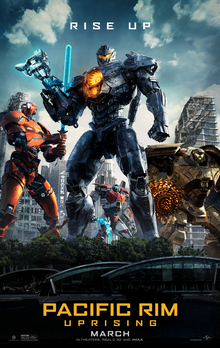 |
If you are a fan of soldiers behaving childishly and lots of cgi giant robots (jaegars) vs. giant energy-blasting lizards (kaiju), then you won't want to miss Pacific Rim Uprising.
The original film, Guillermo del Toro's Pacific Rim (2013), that this film follows, wasn't high-brow cinema, but it did a good job of portraying fantasy/sci-fi action. Some directors may have more of a flare for this than others. The same way that Tarantino specializes in pastiching overly violent and exploitative stories, del Toro is great at presenting worlds of the weird with style and though he remained as producer of Uprising, the directorial chores fell to Steven S. DeKnight, a director whose previous background had been on the small screen with episodes of Spartacus, Buffy the Vampire Slayer, Angel, and Smallville. But given the limitations of the script, DeKnight probably did the best he could.
The story: Ten years have passed since the Kaiju Invasion was defeated and the world has partially rebuilt and partially left things in ruin. The son of the heroic leader Stacker Pentecost (Idras Elba) and former jaegar pilot, Jake (John Boyega), is living mostly as a thief of jaegar components. While in pursuit of such parts, he runs into another technology thief, Amara Namani (Cailee Spaeny), a teen-aged girl orphaned during a kaiju attack, who now lives in the ruined areas collecting what she needs to build her own jaegar. The two are pulled into the jaegar program (as an alternative to jail) by Mako Mori (Rinko Kikuchi), one of the jaegar pilots from the first film and Jake's adoptive sister. They are present as a push is made to replacement the two-man piloted jaegars with drones which can be remotely controlled by a single person. However, the kaiju threat isn't gone as they had hoped and soon things go terribly awry.
Good points: John Boyega, Cailee Spaeny, and Scott Eastwood (playing Jake's co-pilot and head jaegar instructor) are all likeable leads. They all have some dimension to their characters, but not too much, which is probably OK for a story like this. And who doesn't enjoy the spectacle of giant robots fighting giant monsters while leveling dozens of city blocks?
Quibbles: As in Pacific Rim, the characterizations are based on cliches and stereotypes we have seen before - heroes afraid of not being able to live up to their father's expectations, brainy-plucky orphans, true-blue soldier types. Stereotypes are easy ways for viewers to pick up on a character quickly and this film really seems aimed at kids, so maybe this is just fine given the intended audience. But if this film spawns another in the series, they will need to go deeper with these characters.
Similarly to the first film, there is no strong villain. In Pacific Rim, we saw giant monsters attacking for no apparent reason other than that they were the weapons of an extra-dimensional alien invasion (and because that's what giant monsters do). But the nature and intent of the aliens was somewhat vague. Here, their intentions are somewhat clearer, but the vessel they use to spearhead their new invasion attempt seems hard to take seriously. Plots are often dopey in movies like this, but a weak villain with little connection to the main characters tends to take the air out of the story.
And, of course, the whole storyline lies on a somewhat feeble concept. Why are giant robots a better way of combating giant monsters than jets, bombs, and guns, especially when transporting the jaegars requires enormous flying carriers or special rockets and where many of the robots' primary weapons are guns? I know. Why ask why? We just wanted an excuse to have giant robots vs. giant monsters. Admittedly, it's cool to look at, but like Transformers, it's bound to get old at some point.
- JC
____________________
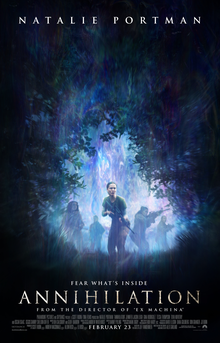 |
Annihilation is writer/director/producer Alex Garland's newest film after his successes 28 Days Later (2002), Sunshine (2007), Never Let Me Go (2011), Dredd (2012), and Ex Machina (2015). If making quality science-fiction fare was baseball, Garland has been a consistent home run hitter. But film-making isn't as cut and dried as baseball. What really constitutes a home run? Annihilation is a quality film, but that doesn't necessarily make it a crowd pleaser.
Our story: Lena (Natalie Portman), a biology professor and former soldier, is still coping with the absence, and assumed death, of her husband, Kane (Oscar Isaac). One day, Kane suddenly appears at their home. However, he is strangely emotionless and has little memory of the past year. Soon, he collapses and Lena calls 911. The ambulance is intercepted by the military and both Kane and Lena are taken to an undisclosed location. Here, Lena speaks with a Dr. Ventress (Jennifer Jason Leigh), who is the government's lead investigator of a phenomena called the "shimmer." The shimmer is an area surrounded by a border of shimmering light bordered on one side by coastline. The area is expanding and until now, no people or devices that have entered have ever returned. Kane, who was part of an expedition that entered the shimmer nearly a year ago, is the first person to come out, but now he is in a coma and apparently dying. In order to try to save Kane's life and because of her unique qualifications as a soldier-scientist, Lena volunteers to join the next mission to investigate inside the shimmer. She joins a team of four other women, a physicist (Tessa Thompson), a geologist (Tuva Novotny), a paramedic (Gina Rodriguez), and Ventress. Once inside, they are exposed to numerous bizarre phenomena as they try to piece together the mystery of what the shimmer is and how to deal with it.
Annihilation easily demonstrates quality science-fiction's attributes of a mystery to be solved as well as an examination of the human condition. However, many audiences will (and have) found it too cerebral to be truly enjoyable. Both in terms of understanding the nature of the phenomena as well as understanding what is going on with the characters, answers are a bit too nebulous to fathom. I spent much of the film straining to decipher what was going on within the shimmer's sphere of influence as well as what was happening with the characters and why. If one is required to have an IQ in excess of 135 to follow the film without additional materials, this renders it inaccessible to the majority of viewers. With this film, as many others, I like to sample other people's takes on a film and found many interesting commentaries. There is an interesting array of views. There are people who simply find it an unenjoyable conundrum. Some struggle to explain their interpretation and some come up with truly insightful ideas as to what it all means. But the film is vague enough that it's impossible to know for certain whose interpretation is most accurate.
In interviews, Garland has said that he read the source novel once and based his screenplay on his recollections of that one reading. So, it may be a departure from what the author, Jeff VanderMeer, may have had in mind. He said that the overarching theme of the story, in his view, is about self destruction. This is an interesting choice, since the shimmer has extraterrestrial origins, but the alien influence seems to reflect the characters' psychological tendencies as much as their physical attributes against them.
I don't mind a puzzle, if it is one that can be solved. But coming away from Annihilation, I get the feeling that not only are pieces missing, but some have been replaced with those from another puzzle. It's a bit of a cheat to the audience. If it was Garland's intention to make a film people would ponder over and argue about over time, then he has achieved his goal. It reminds me of what Churchill said of Russia during WWII, "It is a riddle, wrapped in a mystery, inside an enigma. " We just need a key.
- JC
____________________
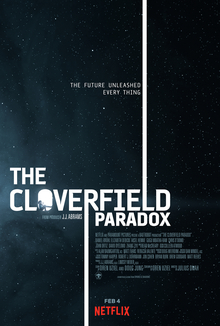 |
In what seemed like J.J. Abrams' continuing pattern of treating the Cloverfield franchise more as a playful hobby and less like one of his bigger projects like Mission: Impossible, Star Trek, or Star Wars, he has taken another standalone sci-fi story and added enough tweaks to fold it into his fractured universe of monsters and aliens.
There was buzz last year of an upcoming film called The God Particle. But no one outside of the Abrams inner circle knew it would be adopted as a Cloverfield installment, much less that it would be announced as a Super Bowl LII commercial and released on Netflix that very night.
The film, set in 2028, describes a possible Earth suffering under a world-wide energy shortage. In desperation, the world's various space agencies send an international team of specialists to the Cloverfield Space Station to attempt to use the Shepard particle accelerator to create a plentiful source of energy. The seven-person team of men and women, all from different nations, spend two years unsuccessfully trying to get the Shepard to work. By this time frustrations are running high. The resource shortages back on Earth have countries at each others' throats and the tensions extend to members of the crew as well. The main protagonist of our story, Ava (Gugu Mbatha-Raw), a British communications officer, misses her husband and is haunted by the past - a power cell she had illegally installed in their home had caused a fire which caused the death of their two children.
Finally, they are able to generate an energy beam, but there is a malfunction that causes the accelerator to overload and causes a power surge to the space station. As the crew cleans up the mess, to their horror, they realize that the Earth has apparently disappeared. As they try to maintain their wits and get the station back in working order, they are subjected to a series of increasingly bizarre and horrifying events which lead them to realize that they may have inadvertently fractured the very fabric of space-time itself.
Critics and fans have savaged this film. At this writing, rottentomatoes.com gives it an approval rating of only 17%. I'm sure that the confusing storytelling and unreasonably high expectations have much to do with this. How and why things occur seems random and nonsensical, but producer Abrams, director Julius Onah, and writer Oren Uziel may have intended it to be this way. One of the characters played by Chris O'Dowd (a welcome comic presence in the film) states, "I don't know the rules now." To which Daniel Bruhl's character, the physicist, later attempts to explain "this is the paradox." "Particles interacting with each other across two dimensions. Two distinct realities in a multiverse, fighting to occupy the same space, creating chaos. These aren't the things we know, because they don't belong to us."
On first viewing, I admit the story doesn't make sense and Abrams' shoehorning it into the Cloverfield storyline doesn't help. But given the luxury of being able to re-view it on Netflix, it's grown on me. No, other than Ava, we don't get a lot of development of the other characters, but the 102 minute runtime doesn't really allow for it. I also suspect a more experienced director could have done a better job of creating more suspense as well. More than once, I was imagining how Ridley Scott or James Cameron might have told the story instead.
But the design of the station is quite realistic and the visuals in space are impressive. No, we don't get a lot of background on the supporting characters, but we do get a sense of all of their personalities, probably due to the quality of the assembled cast. I was also pleasantly surprised by the performance of Elizabeth Debicki. She has developed as an actress since The Man From UNCLE (2015).
While not everyone may be happy with The Cloverfield Paradox, it does present a jumping off point for more stories as the "chaos" of the paradox radiates across space, time, and alternate realities. I will be interested in seeing where the anthology goes from here.
- Swift